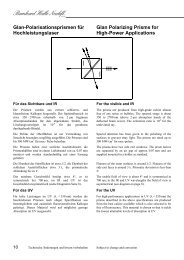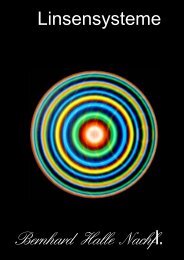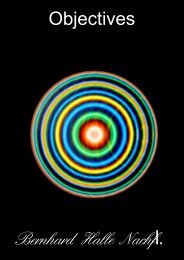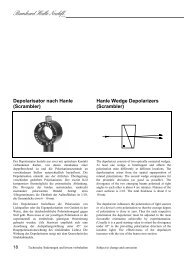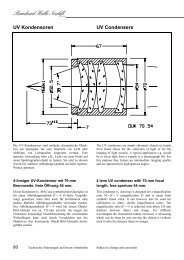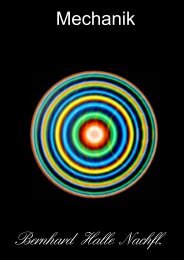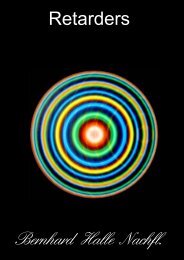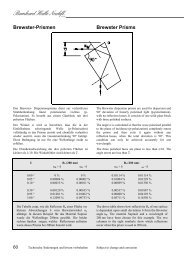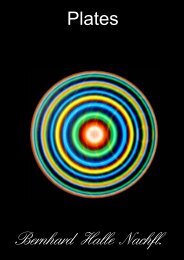Wollaston- und Rochon - Bernhard Halle
Wollaston- und Rochon - Bernhard Halle
Wollaston- und Rochon - Bernhard Halle
Erfolgreiche ePaper selbst erstellen
Machen Sie aus Ihren PDF Publikationen ein blätterbares Flipbook mit unserer einzigartigen Google optimierten e-Paper Software.
<strong>Bernhard</strong> <strong>Halle</strong> Nachfl.<br />
GmbH<br />
Fresnel-Rhomben Fresnel Rhombs<br />
Der Fresnelrhombus dient zur Drehung der<br />
Schwingungsebene linear polarisierten Lichtes. Er besteht<br />
aus zwei mit optischem Kontakt verb<strong>und</strong>enen Fresnelschen<br />
Parallelepipeden aus Kronglas BK 7 oder Quarzglas<br />
Suprasil, die durch vierfache Totalreflexion zusammen eine<br />
Phasendifferenz von 180° zwischen der senkrecht <strong>und</strong><br />
parallel zur Einfallsebene schwingenden Komponente des<br />
Lichtes bewirken. Die Verzögerung ist über einen relativ<br />
weiten Bereich nur wenig von der Wellenlänge abhängig,<br />
siehe Diagramm.<br />
Der Polarisationsdreher ist nur für sehr kleine<br />
Einfallswinkel verwendbar. Der Parallelitätsfehler der<br />
Prismenkombination ist kleiner als 2", die Endflächen sind<br />
senkrecht zur Drehachse justiert.<br />
Die nutzbare Öffnung beträgt 9,5 mm. Die Fassung ist mit<br />
einer Gradteilung von 0° bis 360° versehen <strong>und</strong> wird mit<br />
Reiterstift geliefert. Der Rhombus ist in Kugellagern leicht<br />
drehbar gelagert, so dass auch ein Motorantrieb möglich ist,<br />
jedoch sind die drehenden Teile nicht ausgewuchtet.<br />
The Lambda/2 Fresnel rhomb is used to rotate the plane of<br />
vibration of linearly polarized light. It consists of two<br />
optically contacted Fresnel parallelepipeds of crown glass<br />
BK 7 or quartz glass Suprasil which by total internal<br />
reflection together create a path difference of 180° between<br />
the components of light polarized perpendicular and<br />
parallel to the plane of incidence. Over a relatively wide<br />
range the retardation is only minimally wavelength<br />
dependent, see curve.<br />
This polarization rotator can only be used for very small<br />
acceptance angles. The parallelism error of the prism<br />
combination is less than 2". The end faces are adjusted<br />
perpendicular to the rotation axis.<br />
The usable aperture is 9.5 mm. The holder is provided with<br />
a graduated circle marked from 0° to 360° and is supplied<br />
with a mounting rod. The rhomb is mounted in easily<br />
rotatable ball bearings so that a motor drive can be fitted;<br />
however, the rotating parts are not balanced.<br />
Ausführung für das UV (215 - 450 nm): Version for UV (215 - 450 nm):<br />
Die Parallelepipede sind aus Suprasil hergestellt, die<br />
Verzögerung beträgt zwischen 215 nm <strong>und</strong> 450 nm<br />
180° ± 5% (230 - 350 nm: ± 3%). Die Endflächen sind mit<br />
Einfachschichten mit minimalem Reflexionsvermögen von<br />
1,7% entspiegelt. RFR 215<br />
The parallelepipeds are produced from Suprasil. The<br />
retardation is 180° ± 5% between 215 and 450 nm (230 to<br />
350 nm: ± 3%). The entrance and the exit faces are single<br />
layer antireflection coated with minimal residual<br />
reflectivity of 1.7%. RFR 215<br />
36 Technische Änderungen <strong>und</strong> Irrtum vorbehalten Subject to change and correction



